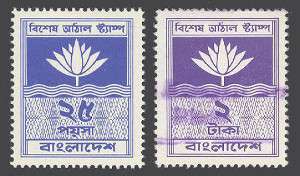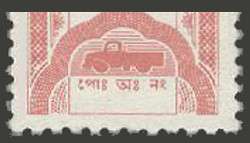DEMONIMATION - POISHA OR TAKA?






The Import stamps on the left show the first letter of “poisha” behind the numerals, and the taka value has the taka symbol in front of the numeral. When the taka symbol is used it is always placed before the numeral. The next values from a Share Transfer set, have “poisha” written under the numerals, but the taka value has the taka symbol in front of the numeral and both the numeral stated in script and the word taka.
DESIGNS OF SOME STAMPS


The above stamps, starting on the left side, are from 1978, two from 1980 and one from 1988, that have numbers written in the boxes. The second stamp on the left appears to have letters, rather than numbers, but the numbers are actually “14141”. Note that the “Post Office Number” is abbreviated in Bangla on the three stamps on the left.
The name of the country is generally at the top of the stamps, but the three stamps on the left, above, have the name near the bottom. Additionally, the type of stamp is written on the stamps, i.e. Insurance, Share Transfer, etc. Because of that, it is easy to determine what type of stamp it is and then one can go to that page to see the denominations, or other information.


